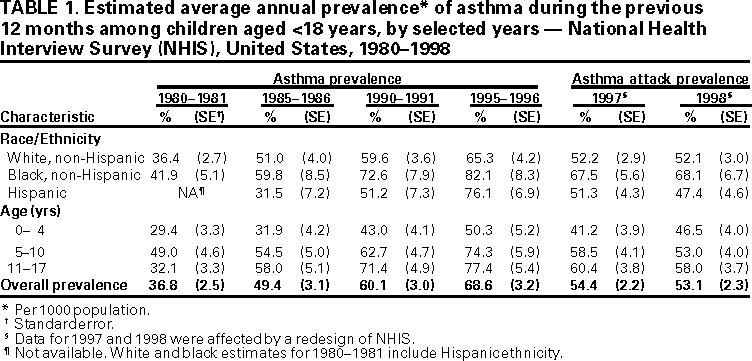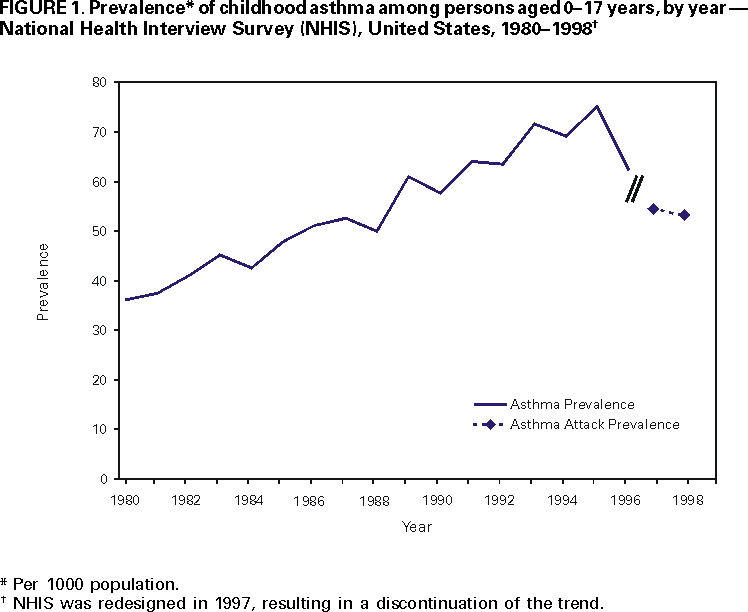 |
|
|
|
|
|
|
| ||||||||||
|
|
|
|
|
|
|
||||
| ||||||||||
|
|
|
|
|
Persons using assistive technology might not be able to fully access information in this file. For assistance, please send e-mail to: mmwrq@cdc.gov. Type 508 Accommodation and the title of the report in the subject line of e-mail. Measuring Childhood Asthma Prevalence Before and After the 1997 Redesign of the National Health Interview Survey --- United StatesAsthma is the most common chronic disease of childhood and a leading cause of disability among children (1,2). Since 1980, asthma prevalence has increased dramatically in children (3,4). The National Health Interview Survey (NHIS), the principal source of asthma prevalence data for the United States, was redesigned in 1997. This report presents NHIS data from 1980--1998 to examine the effect of the redesign on measuring trends in asthma prevalence overall and among age and racial subgroups of children. The findings indicate that although asthma prevalence estimates for 1997--1998 are lower than those preceding changes in the survey design, estimates after 1997 are not comparable to previous estimates. Additional data are needed to establish a new trend after 1997. NHIS is an ongoing household survey of a representative sample of the noninstitutionalized civilian U.S. population. For children aged <18 years, a knowledgeable adult family member, usually a parent, acts as a proxy respondent. Before 1997, one sixth of NHIS-sampled households were asked about chronic respiratory conditions, including asthma (approximately 4500 children in most years). Information on asthma was obtained by the question, "During the past 12 months, did anyone in the family have asthma?" Field testing of a redesigned survey began in 1996, resulting in a 40% decrease in the survey sample compared with previous years. Starting in 1997, information about asthma was collected for a randomly selected sample child in every household containing a child (approximately 14,000 children each year). The redesigned NHIS also specifically obtained information on asthma diagnoses by asking "Has a doctor or other health professional ever told you that your child had asthma?" To determine current asthma attack prevalence, persons answering yes were then asked "During the past 12 months, has your child had an episode of asthma or an asthma attack?" National estimates and standard errors were calculated using SUDAAN. Overall, asthma prevalence among persons aged 0--17 years increased approximately 5% each year during 1980--1995 (Figure 1). The 1996 estimate of 62 per 1000 children (standard error [SE]=4.9) was 17% lower than in 1995 (75 [SE=4.3]). On the basis of the redesigned survey, the 1997 and 1998 prevalence estimates were 54 and 53, respectively, representing the beginning of a new trend. During 1980--1996, prevalence among black non-Hispanic children was greater than that among either white non-Hispanic or Hispanic children (Table 1). The gap between non-Hispanic black and white children widened progressively, from a 15% higher prevalence among blacks during 1980--1981 to 26% during 1995--1996. In the redesigned survey, when compared with white non-Hispanic children, asthma attack prevalence among black non-Hispanic children was 29% higher in 1997 and 31% higher in 1998. From 1985--1986 to 1995--1996, prevalence among Hispanic children increased rapidly. Compared with non-Hispanic white children, asthma prevalence among Hispanic children was 38% lower during 1985--1986 but 17% greater during 1995--1996. In 1997 and 1998, asthma attack prevalence among Hispanic children was similar to that among non-Hispanic white children. Within the three pediatric age groups, prevalence generally increased during 1980--1996. Prevalence also increased with age; children aged >5 years had a higher prevalence than younger children. This pattern was similar for asthma attack prevalence in 1997 and 1998, although the difference between children aged 0--4 years and older children was not statistically significant in 1998. Reported by: Div of Health Interview Statistics; Infant and Child Health Studies Br, Office of Analysis, Epidemiology and Health Promotion, National Center for Health Statistics; Air Pollution and Respiratory Health Br, Div of Environmental Hazards and Health Effects, National Center for Environmental Health; and an EIS Officer, CDC. Editorial Note:Although estimates of asthma prevalence appear lower after 1995 than in earlier years, changes in the number of children surveyed and in the survey design in 1996 and 1997 preclude drawing conclusions about recent changes in childhood asthma. The 1996 survey had a smaller sample size than previous years, resulting in a greater sampling error. The redesigned survey specifically collected information about medical diagnosis of asthma and the frequency of asthma attacks. The redesigned survey also may have differentially affected measurement of asthma prevalence among subgroups in the pediatric population. Among age subgroups, the pattern of asthma attack prevalence appeared unaffected: in 1997 and 1998, children aged 0--4 years continued to have lower asthma attack prevalence compared with older children. However, among race/ethnicity subgroups, asthma attack prevalence estimates declined more for Hispanic than non-Hispanic children. Although the redesign of NHIS created a break in the trend of asthma prevalence, the changes will enable researchers and policy makers to better understand national trends in asthma prevalence. In contrast with the previous question, the redesigned survey measures physician-diagnosed asthma and produces a more specific estimate. In addition, estimating asthma attack prevalence is more helpful for planning public health interventions by measuring the population at risk for serious outcomes from asthma, including hospitalization and death. To promote comparability of surveillance data, the Council of State and Territorial Epidemiologists (CSTE) recommends that a uniform case definition be used by all systems collecting data on self-reported asthma. The 1998 CSTE uniform case definition of self-reported asthma includes a positive response to the survey question, "Did a doctor or other health professional ever tell you (or any household member) that you (they) had asthma?" and a positive response to any one of the following: a) "Do you (or the household member) still have asthma?" b) "Have you (or the household member) taken prescription medications for asthma during the past year?" or c) "Have you (or the household member) had a wheeze episode in the past year?" In addition to the 1997 changes, the 2001 NHIS survey will be modified to adopt a similar case definition by including the question "Do you still have asthma?" Standardized questions for adult asthma prevalence, consistent with the case definition recommended by CSTE, were added to the Behavioral Risk Factor Surveillance System (BRFSS) core module in 2000 and standard questions for child prevalence were added as part of a 2001 module. As a result, three comparable asthma questions for children in both the NHIS and the BRFSS surveys will allow comparisons between local and national asthma prevalence estimates in 2001. Improvements in national and state surveillance will help to identify the factors underlying development and exacerbation of asthma and to develop and target more effective treatment and prevention strategies. References
Table 1  Return to top. Figure 1  Return to top. Disclaimer All MMWR HTML versions of articles are electronic conversions from ASCII text into HTML. This conversion may have resulted in character translation or format errors in the HTML version. Users should not rely on this HTML document, but are referred to the electronic PDF version and/or the original MMWR paper copy for the official text, figures, and tables. An original paper copy of this issue can be obtained from the Superintendent of Documents, U.S. Government Printing Office (GPO), Washington, DC 20402-9371; telephone: (202) 512-1800. Contact GPO for current prices. **Questions or messages regarding errors in formatting should be addressed to mmwrq@cdc.gov.Page converted: 10/12/2000 |
|||||||||
This page last reviewed 5/2/01
|